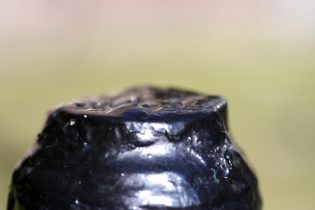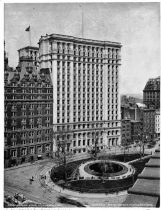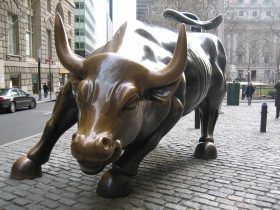Bowling Green is the oldest park in New York. Although it is also possibly one of the smallest parks in the city, it has a fascinating history which can still be seen to this day. Situated at the end of Broadway and near Battery Park, it is a popular subway stop at a crossroad in the city. However, it would be a shame to simply walk past this small piece of land that is willing to give it secrets away to those who look closely at its history. Originally a stockyard for the earliest pilgrims, this area has seen trades, battles, protests, and has watched as New York City evolved into the mecca that it is today. Bowling Green is a living piece of history.
The park has always been a center of activity since its initial founding. It is debated among historians exactly how the Dutch acquired the land from the native population, the Lenope. As tradition holds it, Bowling Green was the site that Peter Minuit paid a supposed $24 for Manhattan. Peter Minuit was the director of the Dutch colony but was later demoted by the Dutch Wet India Company. There is more certainty that Minuit actually made this trade, yet the figure and location are still debated. When the Dutch settled the land in 1624, their commodities they had brought from home were very important as they often couldn’t get them in the New World. Probably the most important of all was their cattle, which provided food and drink. In 1638 the Common Council of the Dutch immigrants chose a piece of land to herd all of their cattle in. This area was referred to by the Dutch as “the Plain” since its primary purpose was for grazing.[1] They most likely chose this piece of land because it was located close to their protective fort.
Later in 1675, it was decided that this area would play host to an annual market for “grain, cattle and other produce of the country.”[2] These settlers were perhaps the first farmers market in the New World. A couple years after this decision in 1677 the first well in the city was dug at this location. Although New York City is a peninsula, there has been a long-standing problem of getting water to the center so people can drink, wash, and put out raging fires! The area stayed a market for several decades. It was not until 1733 that the green space started to become the park that it is today. It that year the Common Council wished for this area to be repurposed as a park and that it would be “the delight of the Inhabitants of the City.”[3] As more and more people came to New York, they slowly crept northward on the island and ran into all the undesirable parts of society at the edge of town. Thus, the cattle market came to a close and a park was erected.
As the power in New York shifted from the Dutch to the English and the island began to take a different form, Bowling Green was re-envisioned. The park became a place of honor for the crown back home. One of the ways in which they honored their leader, King George III, was by erecting an equestrian statue of him in the middle of Bowling Green in 1770. It was the first equestrian statue in the new world and was a statement to everyone in the colony.[4] A newspaper from the time period described the day as follows:
“Thursday last the Statue of his majesty, King George the Third, was fixed on a pedestal erected for it in Bowling Green. His Honor the Lieut. Governor having invited most of the principal Gentlemen in the City, both Civil, and Military; about 12 o’clock they attended his honor in fort George where his majesty’s Health &c. was drank, while there was a discharge of 31 Cannon from the Battery.”[5]
The celebration and statue may have been a lovely moment for his majesty and his health, however, it was equally a sign of power to all those who are against the crown. There were many who dissented from the British laws and were in open disagreement. A revolutionary war was brewing and both sides were ready to face a battle if need be. One group that opposed the rule of the British was the Sons of Liberty. They were seen as troublemakers who often ignited fights outside taverns. They had been known for erecting ‘freedom poles’ made out of ship masts to contest with the statues the British had erected. Since there were hostile tensions between these two groups the park became a frequent are for many protestors. In 1773, a large cast iron fence was made for the perimeter of Bowling Green to protect the statues inside.[6] At the same time, the city enacted a law against desecration and graffiti.[7] This was also the first law of its kind.
The cast iron fence and laws were no deterrent for the Sons of Liberty. The fence has ornately adorned with small crowns, which are an obvious symbol of British rule. Those seeking independence took to the green and cut the crowns off the barrier. The

the original fence still stands, and the hack job can be seen and felt on the fence today. This action of defiance was only the beginning of their violent demonstrations. On July 9, 1776, the Declaration of Independence was read to all of Washington’s troops and was proclaimed to those at City Hall. In this moment, the Sons of liberty rushed with great haste to Bowling Green to tear down the equestrian statue of King George III. After toppling and decapitating the king, they melted the remains and turned them into bullets. According to one report, a total of 43,088 cartridges of bullets were made from the statues.[8] Today only right small fragments of the original statue are said to exist at the New-York Historical Society. It is highly unlikely to see these pieces as they are only on record and kept under lock and key.[9]
Just as the statue toppled, so did the British and a new era of Bowling Green came into being. When the Americans took over they slowly but surely built up the city. The establishment of an actual bowling green in the park gave way to its present name. Although the park itself was not drastically changed for many years, it was an area which people wanted to live by. Several buildings and the surrounding area became a

prized location for anyone notable. The governors’ house was built close to the park, which many hoped would one day house the president. The house never had the honor of gracing a president, yet it did serve the governor or several years. George Washington lived a few blocks away at the Alexander Macomb House for one year in 1790 and was said to frequent the park on his return home.[10]
The small tear dropped shape park began to be more defined by the buildings that surrounded it rather than the events taking place within it. For many years the park sat as simply an area to pass through with benches. During the great depression, the green became neglected and unkempt. Even after the recession ended the park

was not well maintained. There were a few movements to make the park a small hub of the ‘future’, but this was simply a fad and was never brought to fulfillment. It was not until the 1970’s that the park received attention from the city. The city council started to put money back into the infrastructure which included Bowling Park. A fountain was placed in the center, bushes and flowers were added, as well as newly paved walkways. Although never intended to be a permanent attraction, the Charging Bull statue at the top of Bowling green has become a popular tourist attraction. Created by Arturo Di Modica, it represents the popular a power market, as commonly portrayed as a bull.[11]
Visiting Bowling Green could not be any easier. There is a subway station at the foot of the park that houses the 4 and 5 line. The park is also kitty-corner from the much larger Battery Park. Getting to the park is simple and since it is an open air park it is always free. There are little markers in the park itself describing its history, but it is everywhere. Bowling Green has been a mainstay since the founding of New York. The park is truly a stage in which farmers, revolutionaries, presidents, and lawyers have all made their mark in history.
[1] Mary L. Booth, History of the City of New York. 1st ed. Vol. 1.( New York, NY: W.R.C. Clark, 1867), 88.
[2] Ibid., 90.
[3] The Equestrian Statue of George III and the Pedestrian Statue of William Pitt: Erected in the City of New York 1770. New York, NY: New York Historical Society, 1920, 20.
[4] The Equestrian Statue of George III and the Pedestrian Statue of William Pitt: Erected in the City of New York 1770. New York, NY: New York Historical Society, 1920, 40.
[5] New York Journal of the General Advertiser, Aug. 23, 1770.
[6] Mary L. Booth, History of the City of New York. 1st ed. Vol. 1. New York, NY: W.R.C. Clark, 1867, 110.
[7] Robert, Sullivan. “Permanent Revolution A Tour of Tea-party New York—the Spirit of ’76 Kind.” New York 14, no.2 (September 2, 2012): 12-27.
[8] Memorial of Henry Wolcott, one of the first settlers of Windsor, Connecticut, and of some of his descendants. 1881, 188.
[9] “NATIONAL REGISTER DIGITAL ASSETS.” National Park Service. February 11, 2013. (Accessed September 8, 2016.) http://focus.nps.gov/AssetDetail/NRIS/80002673.
[10] Greenfield, Beth, Robert Reid, and Ginger Adams Otis. NYC. New York, NY: Lonely Planet, 2006, 127.
[11] Greenfield, Beth, Robert Reid, and Ginger Adams Otis. NYC. New York, NY: Lonely Planet, 2006, 128.
Annotated Bibliography
Booth, Mary L. History of the City of New York. 1st ed. Vol. 1. New York, NY: W.R.C. Clark, 1867.
This book is a secondary source but it is written very close to many of the important revolutionary activities. There is an entire chapter dedicated to describing how the statue of King George III was torn down. There is significant detail given to the particulars of events and even some firsthand accounts from people at these events, which are primary sources in themselves.
Greenfield, Beth, Robert Reid, and Ginger Adams Otis. NYC. New York, NY: Lonely Planet, 2006.
This is a more modern history of Bowling Green. There are sections on the green in demonstrations on protests. Moreover, the book covers surrounding activates. Most notably the placement of the New York City bull.
“NATIONAL REGISTER DIGITAL ASSETS.” National Park Service. February 11, 2013. Accessed September 8, 2016. http://focus.nps.gov/AssetDetail/NRIS/80002673.
This is the National Park Service website. There is information on not only when the park came into the protection of the government, but also important dates and descriptions of why it is a historically significant park to protect.
Sullivan, Robert. “Permanent Revolution A Tour of Tea-party New York—the Spirit of ’76 Kind.” New York 14, no. 2 (September 2, 2012): 12-27.
An interesting article on existing piece of history within New York. There are two sections on Bowling Green featuring the revolution and change around the post-War World II era.
The Equestrian Statue of George III and the Pedestrian Statue of William Pitt: Erected in the City of New York 1770. New York, NY: New York Historical Society, 1920.
This source tells more about why the statues of King George and William Pitt were erected in the first place. There is also information on how the statues were constructed and on their influence in the art world.
“TEN IMAGES OF BOWLING GREEN AND TEN FACTS ABOUT ITS MARVELOUS HISTORY.” The Bowery Boys: New York City History. March 11, 2015. Accessed September 8, 2016. http://www.boweryboyshistory.com/2015/03/ten-images-of-bowling-green-and-ten-facts-about-its-marvelous-history.html.
This website has 10 photos, or sketches, from every era of the park’s history. This gives good contexts seeing how the park has changed over the years, or lack thereof. With every picture, there is a paragraph or two about where the photo comes from with a short description of what significance it has.
